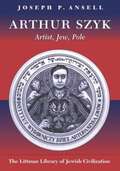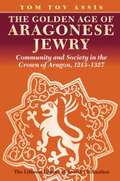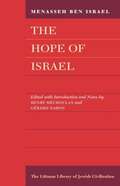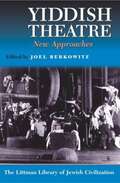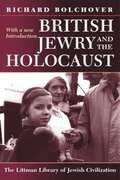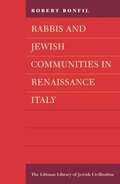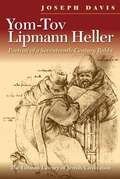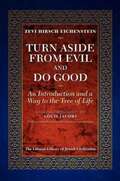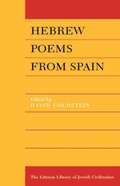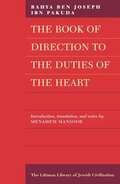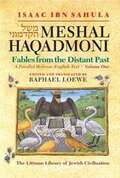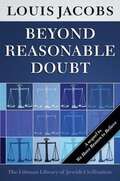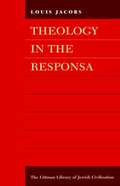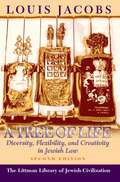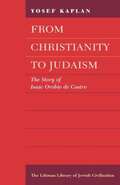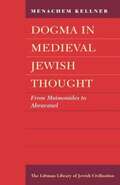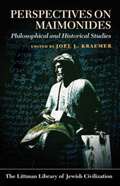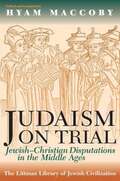- Table View
- List View
The Book of Tahkemoni: Jewish Tales from Medieval Spain (The Littman Library of Jewish Civilization)
by Judah AlhariziNational Jewish Book Awards Winner of Sephardic Studies Award, 2001.The Book of Tahkemoni (The Book of Wisdom or the Heroic) is widely regarded as the crowning jewel of Hebrew maqama literature —rhymed prose interspersed with verse. In its fifty unlinked episodes we repeatedly encounter the somewhat roguish protagonist, Hever the Kenite, often disguised and assuming many and varied roles—teacher, beggar, adventurer, debater, magician, and so on. Whether preaching, spinning history or fantasy, or working a crowd, Hever the Kenite is ever a consummate story-teller and wordsmith enlightening or astounding his listeners. The author, generally considered to be the last major Hebrew poet of Spain, displays great scope, moving from prayers to tales of battlefield carnage, from philosophic reflection to droll satire targeting the pompous, the ignorant, and the mean. The whole is conveyed in a sensuous interweave of rhyme and rhythm, of literal and figurative speech, and copious biblical citations manipulated to serve unusual ends. David Simha Segal's translation captures the drama, wit, and satire of the original in a contemporary English that displays vigour and a sense of fun. Detailed annotations, printed on the same page as the text, identify the numerous allusions. Analyses of each chapter bring the reader more deeply into the text, illuminating plays on words, adroit uses of the frame tale, adaptations of Arabic and Hebrew literary conventions, and other subtleties of the original. A substantial Afterword sums up major features discussed in the analyses, especially the authorial game of hide-and-seek in the characters of the protagonist and the narrator.
Moses Mendelssohn: A Biographical Study (The Littman Library of Jewish Civilization)
by Alexander AltmannAlexander Altmann’s acclaimed, wide-ranging biography of Moses Mendelssohn (1729–96) was first published in 1973, but its stature as the definitive biography remains unquestioned. In fact, there has been no subsequent attempt at an intellectual biography of this towering and unusual figure: no other Jew so deeply rooted in the Jewish tradition was at the same time so much a part of the intellectual life of the German Enlightenment in the second half of the eighteenth century. As such, Moses Mendelssohn came to be recognized as the inaugurator of a new phase in Jewish history; all modern Jews today are in his debt. Altmann presents Moses Mendelssohn in strictly biographical terms. He does not attempt to assess his significance with the hindsight of historical perspective nor to trace his image in subsequent generations, but rather to observe his life from the period within which it was set. Altmann has written an absorbing and compelling narrative that makes a whole epoch come alive with great drama, for Mendelssohn’s life was a kaleidoscope of the European intellectual scene, Jewish and non-Jewish. As both a prominent philosopher and a believing Jew, Mendelssohn became a spokesman for the Jews and Judaism; he was one of the rare figures who become the symbol of an era. Through Altmann’s skilful use of hitherto unpublished archival material, the reader is introduced to the vast array of people—men of letters, artists, politicians, scientists, philosophers, and theologians—with whom Mendelssohn was in contact, and sometimes in conflict. What was Mendelssohn’s Judaism like? To what extent did the disparate worlds of Judaism and modern Enlightenment jostle each other in his mind and to what degree could he harmonize them? These questions are not easily answered, and it is only in the aggregate of a multitude of accounts of experiences, reaction, and statements on his part that the answer is to be found. Alexander Altmann’s analysis of this wealth of material is extraordinary in its discernment, subtlety, and clarity of expression. This masterly work will be of interest not only to those who are concerned with Jewish intellectual history but also to those interested in eighteenth-century cultural and social history, philosophy and theology, literary criticism, aesthetics, and the other areas of intellectual activity in ferment at that time. The general reader will also find much of contemporary relevance in Mendelssohn’s life, not only because of his exemplary devotion to reason and tolerance, but also because of his lifelong struggle with the basic dilemma of the Jew in the modern world: the attraction of assimilation versus the singularity of Jewish life, and the preservation of Jewish identity versus integration in the wider society.
Arthur Szyk: Artist, Jew, Pole (The Littman Library of Jewish Civilization)
by Joseph P. AnsellArtist and illustrator Arthur Szyk was a Polish Jew whose work was overwhelmingly Jewish in theme and content. In a lifetime of creativity that spanned many of the major events of the twentieth century and took him from Poland to France, England, and the United States, the mission he set himself was to use his artistic talents to serve humanity and the Jewish people. Though his politics were dictated by what he thought would be good for the Jews, his work as a political artist went well beyond a narrow definition of the Jewish cause. He is best known among Jews for his illustrated Haggadah, but the overwhelming majority of his work deals with contemporary political themes and social causes. In his native Poland, Szyk promoted the causes of freedom, toleration, and human dignity, drawing his inspiration from the Old Testament. He believed that as a Jewish artist he had a responsibility to speak for all minorities. His famous illustration of the historical Statute of Kalisz symbolized his belief that the newly re-established Polish state would welcome all its citizens into full and equal participation. Even though at that time he was already based outside Poland, he worked for many years on behalf of the Polish government in an effort to strengthen the Jews’ position. Szyk left Europe in 1940 and arrived in the United States via Canada later the same year. Determined as ever to use his art for political purposes, he crusaded against the Nazis through newspaper and magazine cartoons, posters and public exhibitions. Convinced that Hitler would not stop with the Jews but would suppress all freedom-loving people, he supported the war effort through his striking propaganda images of the German and Japanese armies, to great effect. After the war he turned his efforts to promoting the idea of a Jewish homeland in Israel. In every phase of his career, one finds Szyk looking to the past but hoping for the future; he believed that art could make a difference in the world, politically and socially. Joseph Ansell’s biography makes a singular contribution to the history of Jewish art and of Polish-Jewish relations in the first half of the twentieth century.
The Golden Age of Aragonese Jewry: Community and Society in the Crown of Aragon, 1213-1327 (The Littman Library of Jewish Civilization)
by Yom Tov AssisThe medieval Crown of Aragon reached the peak of its power and influence in the thirteenth century, and Jews took an active part in this expansion. In this detailed and meticulously researched study Yom Tov Assis deals with many important aspects of this period, which was truly a 'Golden Age' in the history of Aragonese and Catalan Jewry, both in terms of their relationship with the Crown and of their own cultural achievements. Professor Assis provides the most extensive treatment yet of Jewish self-government in the Hispanic kingdoms and the mutual interdependence of the Jewish and Christian communities. He describes institutions in very great detail, and examines the acute social problems that arose in the Jewish community and the dissent, polemics, and controversies that divided it. He shows how the proximity of the country to France and Provence on the one hand, and to Castile and Andalusia on the other, made Catalan Jewry a point of contact between Ashkenazi and Sephardi Jewry, demonstrating the effect this had on religious and cultural life, and in particular the consequences of the growing influence in Spain of Franco-German Jewry. The book is based on a very wide variety of primary sources-Jewish and non-Jewish, archival and halakhic material, notarial and royal records-in Latin, Catalan, Aragonese, and Hebrew. By drawing on these extensive sources, the author has been able to create a comprehensive description of the social, religious, and administrative aspects of Jewish life that throws much light on the wider society and economy of that period under the Crown of Aragon. The abundant detailed source notes make this an indispensable work of reference for all scholars of medieval Spanish history.
The Hope of Israel (The Littman Library of Jewish Civilization)
by Menasseh Ben-IsraelWhen The Hope of Israel was translated into English in 1652, its argument from Scripture that messianic redemption would not come to the Jewish people until they were scattered in all the corners of the Earth aroused great interest and played an instrumental part in the discussions in the Commonwealth under Cromwell which eventually led to the readmission of the Jews in 1656. This edition of that English text includes an introduction and notes which place the work in the intellectual context of its time.
Yiddish Theatre: New Approaches (The Littman Library of Jewish Civilization)
by Joel BerkowitzThis volume of essays is the first collection of scholarly studies on the Yiddish theatre to appear in English. Drawing on a variety of academic disciplines, it considers the dramatic and musical repertoire of Yiddish theatre and their historical development, popular and critical reception of productions, and the practice and consequences of state censorship. The time-span covered is broad—from the Middle Ages to the twentieth century—as is the geographical range: Cracow, London, Moscow, New York, St Petersburg, Vienna, and Warsaw. Yiddish Theatre not only presents a comprehensive study of the field but also helps illustrate the significance of the Yiddish theatre as a vital form of expression in the Jewish world. Yiddish drama and theatre has had an enormous capacity to entertain audiences on six continents, while at the same time highlighting social, political, religious, and economic concerns of vital interest to the Jewish people. Yiddish Theatre is a valuable resource for scholars, university students, and general readers interested both in Yiddish theatre specifically and related fields such as Jewish literature and culture, east European history and culture, and European and American theatre. The book contains the most comprehensive bibliography to date of sources relating to the Yiddish theatre.CONTRIBUTORS: Ahuva Belkin, Joel Berkowitz Paola Bertolone, Miroslawa M. Bulat, Brigitte Dalinger, Barbara Henry, John Klier, David Mazower, Leonard Prager, Nahma Sandrow, Nina Warnke, Seth L. Wolitz.
The History of the Jews in the Netherlands (The Littman Library of Jewish Civilization)
by J. C. H. Blom R. G. Fuks-Mansfeld I. SchöfferThis history of the Jews of the Netherlands and the role they have played in Dutch society was originally published in Dutch and widely acclaimed for the breadth of its coverage. It covers both the internal evolution of the Jewish community and its social, cultural, and economic interaction with the wider population. From the first Jewish settlements in the medieval duchies of Gelderland, Brabant, and Limburg to the Jewish community of today, the interaction between Dutch Jews and Dutch Christians has mostly been one of fruitful collaboration which only the period of German occupation from 1940 to 1945 was seriously able to disrupt. The contribution that Dutch Jews have made, and continue to make, to cultural life, to the economy, and to science is recognized as being of central importance to the Netherlands as a whole. The ten eminent scholars contributing to this book each describe Jewish life in a particular period, from the Middle Ages to the present. In doing so they consider the strains caused within the Jewish community by the effort to play a full part in Dutch society while maintaining Jewish culture, setting the discussion in the context of trends and tensions within Dutch society in the period in question. The circumstances of the Jews under German occupation and in the immediate post-war period are also discussed. The History of the Jews in the Netherlands is a definitive, indispensable work for the study of both European Jewish and Dutch history.CONTRIBUTORS J. C. H. Blom, F. Chaya Brasz, Joel J. Cahen, Renate G. Fuks-Mansfeld, Jonathan I. Israel, Yosef Kaplan, Peter Romijn, Ivo Schöffer, B. M. J. Speet, Daniel M. Swetschinski
British Jewry and the Holocaust: With a New Introduction (The Littman Library of Jewish Civilization)
by Richard BolchoverHow did British Jewry respond to the Holocaust, how prominent was it on the communal agenda, and what does this response tell us about the values, politics, and fears of the Anglo-Jewish community? This book studies the priorities of that community, and thereby seeks to analyse the attitudes and philosophies which informed actions. It paints a picture of Anglo-Jewish life and its reactions to a wide range of matters in the non-Jewish world. Richard Bolchover charts the transmission of the news of the European catastrophe and discusses the various theories regarding reactions to these exceptional circumstances. He investigates the structures and political philosophies of Anglo-Jewry during the war years and covers the reactions of Jewish political and religious leaders as well as prominent Jews acting outside the community's institutional framework. Various co-ordinated responses, political and philanthropic, are studied, as are the issues which dominated the community at that time, namely internal conflict and the fear of increased domestic antisemitism: these preoccupations inevitably affected responses to events in Europe. The latter half of the book looks at the ramifications of the community's socio-political philosophies including, most radically, Zionism, and their influence on communal reactions. This acclaimed study raises major questions about the structures and priorities of the British Jewish community. For this paperback, the author has added a new Introduction summarizing research in the field since the book's first appearance.
Rabbis and Jewish Communities in Renaissance Italy (The Littman Library of Jewish Civilization)
by Robert BonfilFocusing on the figure of the rabbi, this book provides a vivid picture of Italian Jewry during the Renaissance. The author discusses Jewish life of the period (c.1450–1600) in its social, institutional, and cultural aspects, placing them against the backdrop of the wider Catholic environment to give an original interpretation of how Jewish cultural and religious life developed in the Renaissance context. Particular attention is given to changes in the status and functions of the rabbis and to the relations between the rabbinate and the lay leadership. Of special interest is the exploration of the cultural world of the rabbis and the broader issue of intellectual developments at the time. Essentially a translation of Part I of the Hebrew edition, which won wide acclaim for its perspective, Rabbis and Jewish Communities in Renaissance Italy has been carefully adapted for an English-speaking readership. Substantial excerpts from the appendices have been incorporated into the text so that the evidence necessary to support the arguments is easily accessible.
Pride Versus Prejudice: Jewish Doctors and Lawyers in England, 1890-1990 (The Littman Library of Jewish Civilization)
by John CooperThis pioneering study is a treasure trove of new information, illustrating the lives and professional experiences of the people involved in such a way as to demonstrate clearly both the obstacles they faced and the status they achieved. Its wealth of detail, in many cases fleshing out the careers of leading Jewish professional figures for the first time, makes engaging reading. The narrative proceeds chronologically with careful attention to social context, starting with the Victorian and Edwardian eras. For the medical profession, the account of subsequent changes begins with the influx of Jews into medical schools after 1914. John Cooper goes on to describe the problems these Jewish medical students, most of them from immigrant families, encountered. Finding employment even as general practitioners was problematic, and almost insurmountable barriers confronted aspirants to consultant status. Afraid of antisemitic claims that Jews were flooding the market, the leaders of Anglo-Jewry even tried in the 1930s to dissuade young Jews from becoming doctors and lawyers. In this context, Cooper also considers the position of refugee doctors before and during the Second World War. The establishment of the National Health Service in 1948 resulted in fundamental changes, particularly in the way in which consultants were selected, and Cooper shows how this permitted Jewish doctors to enter specialties from which they had previously been excluded and to climb to the highest rungs within the medical hierarchy. He summarizes the careers of many prominent Jewish doctors. The experience of Jews in the legal profession, both as solicitors and barristers, is examined in similar detail. Cooper sets the context with a discussion of the treatment of Jewish litigants in the early years of the twentieth century in the Whitechapel County Court and the criminal courts. He shows how the persistence of an anti-Jewish bias in the inter-war period limited opportunities for Jews and dissuaded them from entering the law; he also considers the position of Jewish refugee lawyers who came to England during the 1930s and 1940s. After the war, major changes in the economy and legal system allowed Jewish law firms to expand rapidly, challenging the dominance of the City law firms in the commercial world. Many of these firms consequently began to admit Jewish partners for the first time, and Jewish barristers, hitherto confined to the less remunerative areas of civil and criminal law, were likewise able to enter the more lucrative pastures of company and tax law. From the late 1960s, Jews were also promoted in increasing numbers to position on the High Court Bench. As well as giving a detailed picture of these mainstream developments the book also looks at the careers of Jewish communist, socialist, and maverick lawyers. The story John Cooper tells will appeal not only to readers with a general interest in the subject but also to social historians. It is based on a wide range of sources, including newspapers and professional journals, archival material, law reports, and interviews conducted by the author, and there are detailed indexes of names and subjects. As well as providing an illuminating account of recent Jewish social history, the book makes a valuable contribution to the history of the medical and legal professions and to the scholarly debate as to whether or not antisemitism was of peripheral or central importance in Anglo-Jewish history.
Yom-Tov Lipmann Heller: Portrait of a Seventeenth-Century Rabbi (The Littman Library of Jewish Civilization)
by Joseph DavisThis study portrays a man and an age. Yom-Tov Lipmann Heller (1578-1654), author of the famous Mishnah commentary Tosafot yom tov, was a major talmudist, a disciple of the legendary Rabbi Judah Loew of Prague, and himself the distinguished chief rabbi of Prague and Cracow. The time in which he lived began as a ‘golden age’ for the Jews of Prague and the Jews of Poland, an age of prosperity and the rise of Jewish mysticism. During Heller’s lifetime, however, the golden age changed to darkness, and prosperity gave way to war, persecution, plague, and massacres. It was the end of the Middle Ages, the last generation before Spinoza and Shabbetai Zevi. Scholar, preacher, religious and communal leader, Heller embodied a religious and cultural ideal; he was the very model of a seventeenth-century rabbi. Born in Germany, he moved from one end of the world of Ashkenazi Jewry to the other, first to Prague, and then to Poland and the Ukraine. His life was enmeshed in a web of family ties, and bounded by complex rules of class and religion. His writing reflects not only the full heritage of medieval Jewish thought and its crystallization in the seventeenth century, but also the time and place in which he lived. In many ways, he exemplified his age, its achievements, and its limitations. Carefully researched and well written, Joseph Davis’s work is the definitive biography of Heller. He presents a richly detailed study of Heller’s worldview, his conception of Judaism, of the world around him, and of himself within it: the seventeenth century seen through seventeenth-century eyes. Heller was eyewitness to momentous, epoch-making events: the beginning of the Thirty Years’ War and the massacres of 1648. He lived through a time of tumultuous change. Texts such as the sermon in which Heller responded to the new astronomy of Brahe and Kepler, or a poem on the massacres of 1648 in which he enlarged the capacity of Hebrew poetry to express horror are significant in the larger context of Jewish and European history. Heller’s world-view was not static or motionless. His world changed greatly during his lifetime, and his views of it likewise changed greatly over the fifty years from his first writings to his last, from youth to middle age to old age. His personal circumstances also contributed to this: the experience of betrayal, arrest, imprisonment, the death of his children, and other misfortunes led him to wrestle with such questions as the differences between Jews and non-Jews and the meaning of suffering. Davis weaves these developments succinctly into a fascinating narrative that does full justice both to Heller and the momentous events he experienced.
Turn Aside from Evil and Do Good: An Introduction and a Way to the Tree of Life (The Littman Library of Jewish Civilization)
by Zevi EichensteinTurn Aside from Evil and Do Good was written by Zevi Hirsch Eichenstein (1763–1831), a hasidic master and renowned adept in Lurianic kabbalah. He wrote it with the intention of providing a guide to would-be hasidic kabbalists on how to live a holy life. Eichenstein was unusual in the hasidic world in that as well as being a kabbalist he was a competent talmudist and was also acquainted both with the science of his day and with medieval Jewish philosophy. His views differ from those of other hasidic masters, principally in the importance he attributes to studying the kabbalah, which he considers an important antidote to unbelief, and in his more positive attitude to the enjoyment of sexual activity and to business activity; he is concerned to show how both can be integrated in a holy life. This lively translation by Louis Jacobs of the second edition (1850), which includes the notes of R. Zevi Elimelekh of Dynow, gives the reader an insight into a highly unconventional hasidic master and the basic ideas of Lurianic kabbalah as he perceived them. Through hundreds of scholarly annotations, printed at the foot of each page for ease of reference, Louis Jacobs helps the reader to understand the kabbalistic ideas and imagery and other opaque terms, and clarifies the sources to which the author alludes. Turn Aside from Evil and Do Good conveys the full flavour of an original hasidic approach to kabbalism. Immensely readable, it will be of interest to anyone interested in hasidism and Jewish mysticism or the religious way and its social history. Louis Jacobs has added a very accessible introduction to explain the Lurianic system of kabbalah; he also provides biographical details of Eichenstein and his school, and a full bibliography.
The Mystical Origins of Hasidism (The Littman Library of Jewish Civilization)
by Rachel EliorThe words ‘hasid’ and ‘hasidism’ have become so familiar to people interested in the Jewish world that little thought is given to understanding exactly what hasidism is or considering its spiritual and social consequences. What, for example, are the distinguishing features of hasidism? What innovations does it embody? How did its founders see it? Why did it arouse opposition? What is the essential nature of hasidic thought? What is its spiritual essence? What does its literature consist of? What typifies its leadership? What is the secret of its persistence through the centuries? How have scholars explained its origins? Is hasidism an expression of mystical ideas, or a response to changing social circumstances? What is its connection to kabbalah? To Shabateanism? To messianism? What is its relationship to the traditional structures of authority in the Jewish world? This book aims to answer all these questions in a lucid and accessible manner. Rachel Elior focuses on the fundamental positions and the factors of primary importance: the substantial issues that recur in the hasidic texts, including how hasidim have seen themselves over the centuries, how they have constructed a new spiritual and social ideal, and how that ideal has stood the test of reality. The goal is to present the main characteristics of the hasidic movement and to examine the social implications of its mystical ideas. The text is fully supported by references to the relevant hasidic sources and academic literature. The book concludes with a list of the hasidic texts on which the discussion is based and a comprehensive bibliography of scholarly works on kabbalah and hasidism.
New Perspectives on the Haskalah (The Littman Library of Jewish Civilization)
by Shmuel Feiner David SorkinThis volume, written by a range of scholars in history and literature, offers a new understanding of one of the central cultural and ideological movements among Jews in modern times. Disengaging the Haskalah from the questions of modernization or emancipation that have hitherto dominated the scholarship, the contributors put the Haskalah under a microscope in order to restore detail and texture to the individuals, ideas, and activities that were its makers in the eighteenth and nineteenth centuries. In particular, they replace simple dichotomies with nuanced distinctions, presenting the relationship between ‘tradition’ and Haskalah as a spectrum of closely linked cultural options rather than a fateful choice between old and new or good and evil. The essays address major and minor figures; ask whether there was such an entity as an ‘early Haskalah’, or a Haskalah movement in England, look at key issues such as the relationship of the Haskalah to Orthodoxy and hasidism, and also treat such neglected subjects as the position of women. New Perspectives on the Haskalah will interest all students of modern Jewish history, literature, and culture. CONTRIBUTORS: Harris Bor, Edward Breuer, Tova Cohen, Immanuel Etkes, Shmuel Feiner, Yehuda Friedlander, David B. Ruderman, Joseph Salmon, Nancy Sinkoff, David Sorkin, Shmuel Werses.
Haskalah and History: The Emergence of a Modern Jewish Historical Consciousness (The Littman Library of Jewish Civilization)
by Shmuel FeinerShmuel Feiner's innovative book recreates the historical consciousness that fired the Haskalah—the Jewish Enlightenment movement. The proponents of this movement advocated that Jews should capture the spirit of the future and take their place in wider society, but as Jews—without denying their collective identity and without denying their past. Claiming historical legitimacy for their ideology and their vision of the future, they formulated an ethos of modernity that they projected on to the universal and the Jewish past alike. What was the image of the past that the maskilim shaped? What tactics underpinned their use of history? How did their historical awareness change and develop—from the inception of the Haskalah in Germany at the time of Mendelssohn and Wessely, through the centres of Haskalah in Austria, Galicia, and Russia, to the emergence of modern nationalism in the maskilic circles in eastern Europe in the last third of the nineteenth century? These are some of the questions raised in this fascinating exploration of an ideological approach to history which throws a searching new light on the Jewish Enlightenment movement and the emergence of Jewish historical consciousness more generally.
Hebrew Poems from Spain (The Littman Library of Jewish Civilization)
by David GoldsteinThe years 950-1200 are often called the Golden Age of the Jews in Spain. During this period, the Jews reached a peak of achievement in all aspects of their life—political, spiritual, and cultural. They produced great works of literature and philosophy; their poetry represents a peak of literary achievement unparalleled in Hebrew until the twentieth century. The poets of the Golden Age forged the language of the Hebrew Bible into a magnificent instrument for the expression of every facet of their experience--love and friendship, war and exile, philosophy and prayer. Their poems reflect their overarching consciousness of Israel’s relationship with God and their deep concern with the fate of the Jewish people in exile. Not until modern times did Hebrew poetic genius flourish again with such freedom and with such intensity. This volume conveys in modern English something of the greatness of that literature while as far as possible preserving the poetic values and beauty of the Hebrew original. Brief notes on the work of each of the thirteen poets represented put the poems in their proper perspective and do much to elucidate their meaning. The poets included are Dunash Halevi ben Labrat, Joseph ibn Abithur, Isaac ibn Kalpon, Samuel Hanagid, Solomon ibn Gabirol, Isaac ibn Gi’at, Moses ibn Ezra, Judah Halevi, Abraham ibn Ezra, Joseph ibn Zabara, Judah Alharizi, Shem Tob ben Palquera, and Todros ben Judah Abulafia. ‘Remains the only anthology in English devoted entirely to the Golden Age with selections from all the major and some minor poets presented in verse translations. The book is a gift to the academic world and to all readers interested in the literary achievements of the Jews.’ From the Foreword by Raymond Scheindlin
The Book of Direction to the Duties of the Heart (The Littman Library of Jewish Civilization)
by Bahya Ben PakudaBahya Ibn Pakuda was born c. 1050, and lived for some time in Saragossa in Spain. His major work was written in Arabic, but it is most well-known by its Hebrew title Hovot ha-Levavot (Duties of the Heart). It enjoyed enormous popularity and was reprinted many times. In the book Bahya investigates the motivation of Jewish practice and embarks on a philosophical enquiry into the nature of God, religion, and man. He was very much influenced by the Neoplatonism of his age, as well as by the Muslim mystics. This edition by Menahem Mansoor is the first translation of the work from the original Arabic text, and this shows a number of variations from the Hebrew version. He has added an Introduction and Notes which draw attention to the influences on Bahya’s thought and to other relevant material. ‘The accepted and normative translation . . . reliable and readable. This book belongs in even the smallest collections of Judaica, as well as of ethical literature.’ Choice
Meshal Haqadmoni: A Parallel Hebrew-English Text (The Littman Library of Jewish Civilization)
by Raphael LoeweThe wondrous fables of Ibn Sahula in Meshal haqadmoni, presented here in English for the first time, provide a most unusual introduction to the intellectual and social universe of the Sephardi Jewish world of thirteenth-century Spain. Ibn Sahula wrote his fables in rhymed prose, here rendered into English as rhymed couplets. They comprise a series of satirical debates between a cynic and a moralist, put into the mouths of animals; the moralist always triumphs. The debates, which touch on such subjects as time, the soul, the physical sciences and medicine, astronomy, and astrology, amply reflect human foibles, political compromise, and court intrigue. They are suffused throughout with traditional Jewish law and lore, a flavour reinforced by the profusion of biblical quotations reapplied. With parallel Hebrew and English texts, explanatory notes, indication of textual variants, and references for all the biblical and other allusions, this edition has much to offer to scholars in many areas: medieval Hebrew literature, medieval intellectual history, Sephardi studies, and the literature and folklore of Spain. Both the translation and the scholarly annotations reflect Raphael Loewe’s deep understanding of Ibn Sahula’s world, including the interrelationship of Hebrew, Greek, and Arabic speculative thought and the interplay between those languages. Scholars will profit enormously from the textual annotations, and specialist and non-specialist alike will benefit from the masterly introduction. Two full series of illustrations are reproduced alongside the text: the woodcuts from the second edition (Venice, c.1547), and the splendid vignettes in the Rothschild Miscellany, a fifteenth-century Italian mansucript in the Israel Museum.
Beyond Reasonable Doubt (The Littman Library of Jewish Civilization)
by Louis JacobsMore than forty years have passed since Louis Jacobs first put forward the argument that traditionally observant Jews have no reason to take issue with the results obtained by the historical critics in their investigation into the Bible and the other classical sources of Judaism. In his numerous works on Jewish theology and in lectures worldwide, Jacobs has argued that the traditional doctrine which claims that ‘the Torah is from Heaven’ can and should be maintained — provided that the word ‘from’ is understood in a non-fundamentalist way to denote that there is a human as well as a divine element in the Torah: God revealing His will not only to but through the Jewish people in their historical experiences as they reached out to Him. As a result of these views, which were first published in the still-controversial text We Have Reason to Believe, the Anglo-Jewish Orthodox hierarchy banned Jacobs from serving as an Orthodox rabbi. This was the cause of the notorious ‘Jacobs affair’, which culminated in the creation of the New London Synagogue and, eventually, in the establishment of the Masorti movement in the UK with strong affinities with Conservative Judaism in the United States. In this book, Louis Jacobs examines afresh all the issues involved. He does so objectively but with passion, meeting the objections put forward by critics from the various trends within the Jewish world, both Orthodox and Reform, and inviting readers to follow the argument and make up their own minds.
Theology in the Responsa (The Littman Library of Jewish Civilization)
by Louis JacobsResponsa are replies given by prominent rabbinic authorities to questions put to them by other scholars, asking for rulings on specific issues, generally of a practical nature. The responsa literature is thus a repository of the learning and sound sense of some of the greatest rabbinic authorities over a period of more than a thousand years down to the present, and relates to all the countries where Jews have lived. Although most of the emphasis in the responsa literature is undoubtedly on practice, nearly all the great compilations of responsa also contain discussions of a theological nature since changing conditions posed problems for belief as well as practice. In this volume, first published in 1975 and unrivalled in its treatment of the subject, Louis Jacobs examines those responsa in which theology is considered and highlights the changes that have occurred in the theological principles affecting the rabbis’ attitudes to such questions as life after death, reward and punishment, and the problem of suffering.
A Tree of Life: Diversity, Flexibility and Creativity in Jewish Law [Second Edition] (The Littman Library of Jewish Civilization)
by Louis JacobsThis study of the Jewish legal system (the Halakhah) demonstrates that the law embraces every corner of life.
From Christianity to Judaism: Story of Isaac Orobio de Castro (The Littman Library of Jewish Civilization)
by Yosef KaplanIsaac Orobio de Castro, a crypto-Jew from Portugal, was one of the most prominent intellectual figures of the Sephardi Diaspora in the seventeenth century. After studying medicine and theology in Spain, and having pursued a distinguished medical career, he was arrested by the Spanish Inquisition for practising Judaism, tortured, tired, and imprisoned. He subsequently emigrated to France and became a professor of medicine at the University of Toulouse before openly professing his Judaism and going to Amsterdam where he joined the thriving Portuguese Jewish community. Amsterdam was then a city of great cultural creativity and religious pluralism where Orobio found open to him the world of religious thinkers and learned scholars. In this atmosphere he flourished and became an outstanding spokesman and apologist for the Jewish community. He engaged in controversy with Juan de Prado and Baruch Spinoza, who were both excommunicated by the Portuguese Jewish community, as well as with Christian theologians of various sects and denominations, including Philip van Limborch. This fascinating biography of Orobio sheds light on the complex life of a unique Jewish community of former Christians who had openly returned to Judaism. It focuses on the particular dilemmas of the converts, their attempts to establish boundaries between their Christian past and their new identity, their internal conflicts, and their ability to create new forms of Jewish life and expression.
Dogma in Medieval Jewish Thought: From Maimonides to Abravanel (The Littman Library of Jewish Civilization)
by Menachem KellnerDogma in Medieval Jewish Thought is an essay in the history of ideas which traces the development of creed formation in Judaism from its inception with Moses Maimonides (1138-1204) to the beginning of the sixteenth century when systematic attention to the problem disappeared from the agenda of Jewish intellectuals. The dogmatic systems of Maimonides, Duran, Crescas, Albo, Bibago, Abravanel, and a dozen lesser-known figures are described, analysed, and compared. Relevant texts are presented in English translation. For the most part these are texts which have never been critically edited and translated before. Among the theses defended in the book are the following: that systematic attention to dogma qua dogma was a new feature in Jewish theology introduced by Maimonides (for reasons examined at length in the book); that the subject languished for the two centuries after Maimonides’ death until it was revived in fifteenth-century Spain in response to Christian attacks on Judaism; that the differing systems of dogma offered by medieval Jewish thinkers reflect not different conceptions of what Judaism is, but different conceptions of what a principle of Judaism is; and that the very project of creed formation reflects an essentially Greek as opposed to a biblical/rabbinic view of the nature of religious faith and that this accounts for much of the resistance which Maimonides’ innovation aroused.
Perspectives on Maimonides: Philosophical and Historical Studies (The Littman Library of Jewish Civilization)
by Joel KraemerLeading scholars have combined forces to produce this volume on the philosophy and legal views of Moses Maimonides (1138–1204) and the historical context in which he worked. The philosophical section examines Maimonides’ ethical doctrine; his paradoxical life-style; his Guide of the Perplexed; his attitude to mysticism; his use of language; and his theory of astronomy. The legal section deals with law and medicine, the relation of Maimonides’ legal thought to the Talmud; his doctrine of a just war; and his theory of redemption and Messianism. The history section examines Maimonides’ accession to the position of head of the Jewish community in its historical context, at the time of the rise of the ‘Ayyubid dynasty under Saladin.
Judaism on Trial: Jewish-Christian Disputations in the Middle Ages (The Littman Library of Jewish Civilization)
by Hyam MaccobyHyam Maccoby's now classic study focuses on the major Jewish—Christian disputations of medieval Europe: those of Paris (1240), Barcelona (1263), and Tortosa (1413–14). It examines the content of these theological confrontations with a sense of present-day relevance, while also discussing the use made of scriptural proof-texts. Part I provides a general thematic consideration of the three disputations and their social and historical background. Part II is a complete translation of the account of the Barcelona Disputation written by Nahmanides, one of the greatest figures in the history of Jewish learning, and was Jewish spokesman at the disputation. Part III contains Jewish and Christian accounts of the Paris and Tortosa disputations. A new introduction reviews the relevant literature that has been published since the original edition appeared.


